制药工程专业英语
- 格式:pdf
- 大小:617.80 KB
- 文档页数:5
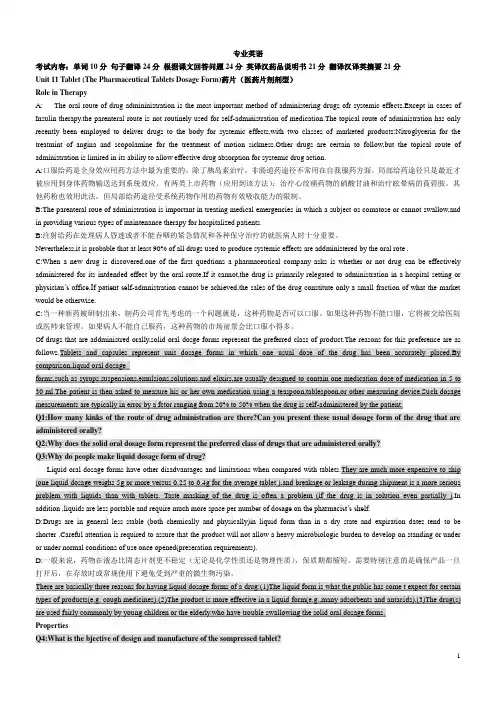
专业英语考试内容:单词10分句子翻译24分根据课文回答问题24分英译汉药品说明书21分翻译汉译英摘要21分Unit 11 Tablet (The Pharmaceutical Tablets Dosage Form)药片(医药片剂剂型)Role in TherapyA: The oral route of drug admininistration is the most important method of administering drugs ofr systemic effects.Except in cases of Insulin therapy.the parenteral route is not routinely used for self-administration of medication.The topical route of administration has only recently been employed to deliver drugs to the body for systemic effects,with two classes of marketed products:Nitroglycerin for the treatmint of angina and scopolamine for the treatment of motion sickness.Other drugs are certain to follow,but the topical route of administration is limited in its ability to allow effective drug absorption for systemic drug action.A:口服给药是全身效应用药方法中最为重要的。
除了胰岛素治疗,非肠道药途径不常用在自我服药方面。
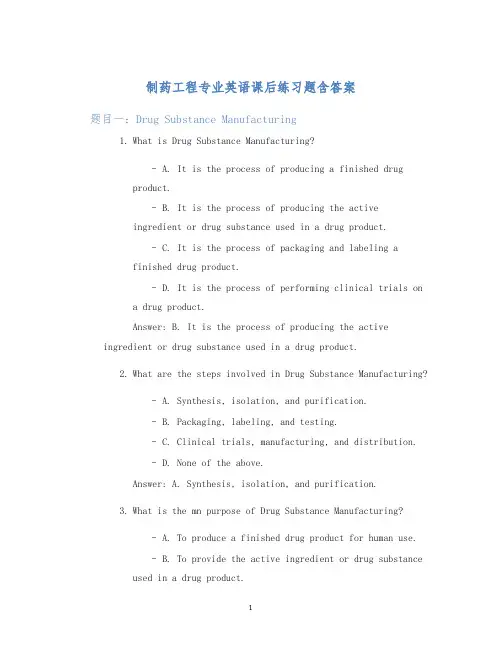
制药工程专业英语课后练习题含答案题目一:Drug Substance Manufacturing1.What is Drug Substance Manufacturing?–A. It is the process of producing a finished drug product.–B. It is the process of producing the activeingredient or drug substance used in a drug product.–C. It is the process of packaging and labeling a finished drug product.–D. It is the process of performing clinical trials ona drug product.Answer: B. It is the process of producing the active ingredient or drug substance used in a drug product.2.What are the steps involved in Drug Substance Manufacturing?–A. Synthesis, isolation, and purification.–B. Packaging, labeling, and testing.–C. Clinical trials, manufacturing, and distribution.–D. None of the above.Answer: A. Synthesis, isolation, and purification.3.What is the mn purpose of Drug Substance Manufacturing?–A. To produce a finished drug product for human use.–B. To provide the active ingredient or drug substance used in a drug product.–C. To test and validate the safety and efficacy of a drug product.–D. To distribute a drug product to consumers.Answer: B. To provide the active ingredient or drug substance used in a drug product.题目二:Pharmaceutical Formulation1.What is Pharmaceutical Formulation?–A. It is the process of producing a finished drug product.–B. It is the process of selecting and combining ingredients to produce a drug product.–C. It is the process of packaging and labeling a finished drug product.–D. It is the process of performing clinical trials ona drug product.Answer: B. It is the process of selecting and combining ingredients to produce a drug product.2.What are the key considerations in PharmaceuticalFormulation?–A. Safety, efficacy, and stability.–B. Cost, avlability, and taste.–C. Appearance, texture, and smell.–D. None of the above.Answer: A. Safety, efficacy, and stability.3.What is the role of excipients in Pharmaceutical Formulation?–A. They are the active ingredients in a drug product.–B. They are the inactive ingredients in a drug product that help to improve its properties.–C. They are the ingredients in a drug product that are responsible for the color and flavor.–D. None of the above.Answer: B. They are the inactive ingredients in a drug product that help to improve its properties.题目三:Good Manufacturing Practice (GMP)1.What is Good Manufacturing Practice (GMP)?–A. It is a set of regulations and guidelines that ensure the quality and safety of pharmaceutical products.–B. It is a set of regulations and guidelines that ensure the efficacy of pharmaceutical products.–C. It is a set of regulations and guidelines that ensure the affordability of pharmaceutical products.–D. None of the above.Answer: A. It is a set of regulations and guidelines that ensure the quality and safety of pharmaceutical products.2.What are the key components of Good Manufacturing Practice(GMP)?–A. Quality control, documentation, and facility design.–B. Clinical trials, manufacturing, and distribution.–C. Cost control, inventory management, and customer service.–D. None of the above.Answer: A. Quality control, documentation, and facility design.3.Why is Good Manufacturing Practice (GMP) important?–A. It helps to ensure the quality and safety ofpharmaceutical products.–B. It helps to reduce the cost of producingpharmaceutical products.–C. It helps to increase the avlability ofpharmaceutical products.–D. None of the above.Answer: A. It helps to ensure the quality and safety of pharmaceutical products.总结本文介绍了制药工程专业英语中的几个重要概念和术语,包括Drug Substance Manufacturing(药品物质制造)、Pharmaceutical Formulation(制剂开发)以及Good Manufacturing Practice(良好生产规范)。

制药工程专业英语详细Unit..详细翻译————————————————————————————————作者:————————————————————————————————日期:Unit 1 Production of Drugs根据其生产或来源不同药物制剂可以分为三类:Ⅰ.人工合成材料(全合成材料)Ⅱ.天然产物,和Ⅲ.半合成天然产物(半合成药物)。
本书的重点是这些第一组和第三组化合物都是合成药物。
然而这并不意味着那些天然药物和其他药物就不重要。
他们可以作为很有价值的先导结构,并经常被用为重要合成药物的原料或中间体。
表1概述了获取药物制剂的不同方法。
Table 1 Possibilities for the preparation of drugs表1药物制备的可能性方法例子1.全合成75%以上的药物制剂都是全合成的(合成物)2.从天然产物中分离(天然产物)2.1植物生物碱;酶;强心甙;多聚糖;维生素E; 类固醇前体(薯蓣皂苷配基,谷甾醇);柠檬醛(中间产物维生素A,E,K)2.2动物器官酶;多肽;激素;胆酸;胆汁;胰岛素来自胰腺;血清和疫苗2.3其他来源胆固醇来自羊毛油;L-氨基酸来自角蛋白和明胶水解3.发酵抗生素; L -氨基酸,葡聚糖;对甾类有定向的修饰,例如11 -羟基化;胰岛素,干扰素,抗体,肽类激素,酶,疫苗生物碱化合物;半合成内酰胺类抗生素;甾类;人胰岛素4.天然产物的半合成修改(半合成药物)几种最初来自于天然原料有治疗意义天然产物如今用更有效也就是经济的全合成法制备。
这样的例子包括L-氨基酸,氯霉素,咖啡因,多巴胺,肾上腺素,左旋多巴,肽类激素,前列腺素,D -青霉胺,长春蔓胺,以及几乎所有的维生素。
在过去的几年里发酵(即微生物处理)变得极其重要。
通过现代技术和遗传选择的结果产生了高效能微生物突变株,发酵已成为广泛的底物(物质)都可以选择的一种方法。
真核微生物(酵母菌和霉菌)和原核微生物(单细胞细菌和放线菌)用于微生物。


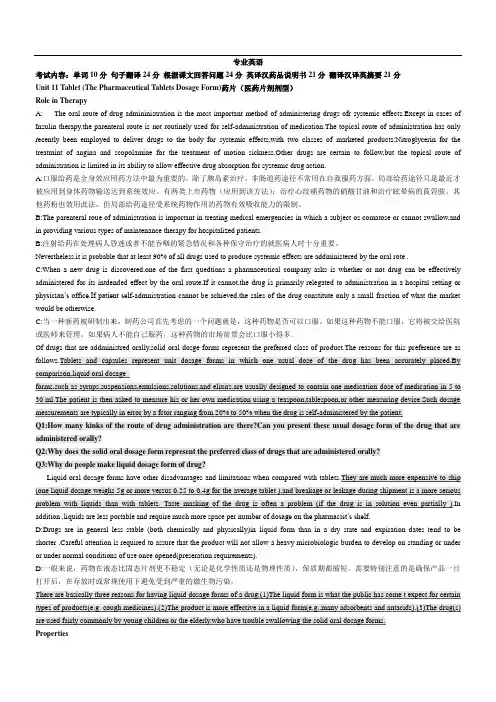
专业英语考试内容:单词10分句子翻译24分根据课文回答问题24分英译汉药品说明书21分翻译汉译英摘要21分Unit 11 Tablet (The Pharmaceutical Tablets Dosage Form)药片(医药片剂剂型)Role in TherapyA: The oral route of drug admininistration is the most important method of administering drugs ofr systemic effects.Except in cases of Insulin therapy.the parenteral route is not routinely used for self-administration of medication.The topical route of administration has only recently been employed to deliver drugs to the body for systemic effects,with two classes of marketed products:Nitroglycerin for the treatmint of angina and scopolamine for the treatment of motion sickness.Other drugs are certain to follow,but the topical route of administration is limited in its ability to allow effective drug absorption for systemic drug action.A:口服给药是全身效应用药方法中最为重要的。
除了胰岛素治疗,非肠道药途径不常用在自我服药方面。

制药工程专业英语--1单元Unit 11.Depending on their production or origin pharmaceutical agents can be splitinto three groups: Totally synthetic material (synthetics) Naturalproducts ,and Product from partial syntheses (semi-synthetic products)依据其生产或来源,药物制剂可以分为三类:I.完全的合成材料(人工合成材料),II.天然产物,和III.源自部分合成的产品(半合成产品)。
2.The emphasis of the present book is on the most important compoundsof groups I and III-thus Drug synthesis.翻译:所以本书的重点是I和III部分的药物合成。
本书的重点是在于Ⅰ和Ⅲ类中最重要的化合物——药物合成。
3.This does not mean, however , that natural products or other agents areless important.然而这并不意味着,天然产物和其他试剂不重要。
4.they can serve as valuable lead structures, and they are frequently needed as starting materials or as intermediates fo r important synthetic products.它们可以作为有价值的先导结构,他们常常作为重要的合成产品的起始原料或中间体产品。
5:Table1gives an overview of the different methods for obtaining pharmaceutical agents.表1列出了获取药物制剂的不同方法的概述。
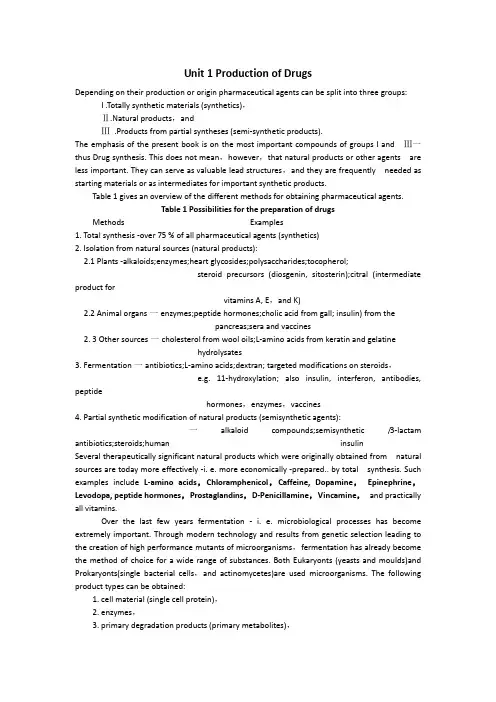
Unit 1 Production of DrugsDepending on their production or origin pharmaceutical agents can be split into three groups:I .Totally synthetic materials (synthetics),Ⅱ.Natural products,andⅢ.Products from partial syntheses (semi-synthetic products).The emphasis of the present book is on the most important compounds of groups I and Ⅲ一thus Drug synthesis. This does not mean,however,that natural products or other agents are less important. They can serve as valuable lead structures,and they are frequently needed as starting materials or as intermediates for important synthetic products.Table 1 gives an overview of the different methods for obtaining pharmaceutical agents.Table 1 Possibilities for the preparation of drugsMethods Examples1. Total synthesis -over 75 % of all pharmaceutical agents (synthetics)2. Isolation from natural sources (natural products):2.1 Plants -alkaloids;enzymes;heart glycosides;polysaccharides;tocopherol;steroid precursors (diosgenin, sitosterin);citral (intermediate product forvitamins A, E,and K)2.2 Animal organs一enzymes;peptide hormones;cholic acid from gall; insulin) from thepancreas;sera and vaccines2. 3 Other sources一cholesterol from wool oils;L-amino acids from keratin and gelatinehydrolysates3. Fermentation一antibiotics;L-amino acids;dextran; targeted modifications on steroids,e.g. 11-hydroxylation; also insulin, interferon, antibodies, peptidehormones,enzymes,vaccines4. Partial synthetic modification of natural products (semisynthetic agents):一alkaloid compounds;semisynthetic /3-lactam antibiotics;steroids;human insulinSeveral therapeutically significant natural products which were originally obtained from natural sources are today more effectively -i. e. more economically -prepared.. by total synthesis. Such examples include L-amino acids,Chloramphenicol,Caffeine, Dopamine,Epinephrine,Levodopa, peptide hormones,Prostaglandins,D-Penicillamine,Vincamine,and practically all vitamins.Over the last few years fermentation - i. e. microbiological processes has become extremely important. Through modern technology and results from genetic selection leading to the creation of high performance mutants of microorganisms,fermentation has already become the method of choice for a wide range of substances. Both Eukaryonts (yeasts and moulds)and Prokaryonts(single bacterial cells,and actinomycetes)are used microorganisms. The following product types can be obtained:1. cell material (single cell protein),2. enzymes,3. primary degradation products (primary metabolites),4. secondary degradation products (secondary metabolites).Disregarding the production of dextran from the mucous membranes of certain microorganisms,e. g. Leuconostoc mesenteroides,classes 2 and 3 are the relevant ones for the preparation of drugs. Dextran itself,with a molecular weight of 50,000 ~ 100,000,is used as a blood plasma substitute. Among the primary metabolites the L-amino acids from mutants of Corynebacterium glutamicum and Brevibacterium flavum are especially interesting. From these organisms some 350,000 tones of monosodium L-glutamate (food additive)and some 70,000 tones of L-lysine(supplement for vegetable proteins)are produced. Further important primary metabolites are the purina nucleotides,organic acids,lactic acid,citric acid,and vitamins,for example vitamin B,2 from Propionibacterium shermanii.Among the secondary metabolites the antibiotics must be mentioned first. The following five groups represent a yearly worldwide value of US-$17 billion:penicillins ( Penicillium chrysogenum ),cephalosporins ( Cephalosporium acremonium ),tetracyclines ( Streptomyces aureofaciens ),erythromycins ( Streptomyces erythreus ),aminoglycosides (e. g. streptomycin from Streptomyces griseus).About 5000 antibiotics have already been isolated from microorganisms,but of these only somewhat fewer than 100 are in therapeutic use. It must be remembered,however,that many derivatives have been modified by partial synthesis for therapeutic use;some 50,000 agents have been semisynthetically obtained from户lactams alone in the last decade. Fermentations are carried out in stainless steel fermentors with volumes up to 400 m3. To avoid contamination of the microorganisms with phages etc. the whole process has to be performed under sterile conditions. Since the more important fermentations occur exclusively under aerobic conditions a good supply of oxygen or air(sterile)is needed. Carbon dioxide sources include carbohydrates,e. g. molasses,saccharides,and glucose. Additionally the microorganisms must be supplied in the growth medium with nitrogen-containing compounds such as ammonium sulfate,ammonia,or urea,as well as with inorganic phosphates. Furthermore,constant optimal pH and temperature are required. In the case of penicillin G,the fermentation is finished after 200 hours,and the cell mass is separated by filtration. The desired active agents are isolated from the filtrate by absorption or extraction processes. The cell mass,if not the desired product,can be further used as an animal feedstuff owing to its high protein content.By modern recombinant techniques microorganisms have been obtained which also allow production of peptides which were not encoded in the original genes. Modified E. coli bacteria make it thus possible to produce A- and B- chains of human insulin or proinsulin analogs. The disulfide bridges are formed selectively after isolation,and the final purification is effected by chromatographic procedures. In this way human insulin is obtained totally independently from any pancreatic material taken from animals.Other important peptides,hormones,and enzymes,such as human growth hormone (HGH),neuroactive peptides,somatostatin,interferons,tissue plasminogen activator (TPA),lymphokines,calcium regulators like calmodulin,protein vaccines,as well as monoclonal antibodies used as diagnostics,are synthesized in this way.The enzymes or enzymatic systems which are present in a single microorganism can be used for directed stereospecific and regiospecific chemical reactions. This principle is especially usefulin steroid chemistry. Here we may refer only to the microbiological 11-a- hydro xylation of progesterone to 11-a-hydroxyprogesterone,a key product used in the synthesis of cortisone. Isolated enzymes are important today not only because of the technical importance of the enzymatic saccharification of starch,and the isomerization of glucose to fructose,They are also significant in the countless test procedures used in diagnosing illness,and in enzymatic analysis which is used in the monitoring of therapy.A number of enzymes are themselves used as active ingredients. Thus preparations containing proteases (e. g. chymotrypsin,pepsin,and trypsin),amylases and lipases,mostly in combination with synthetic antacids,promote digestion. Streptokinase and urokinase are important in thrombolytics,and asparaginase is used as a cytostatic agent in the treatment of leukemia.Finally mention must be made of the important use of enzymes as `biocatalysts’in chemical reactions where their stereospecificity and selectivity can be used. Known examples are the enzymatic cleavage of racemates of N-acetyl-D,L-amino acids to give L-amino acids,the production of 8-aminopenicillanic acid from benzylpenicillin by means of penicillinamidase and the aspartase-catalysed stereospecific addition of ammonia to fumaric acid in order to produce L-aspartic acid.In these applications the enzymes can be used in immobilized forms-somehow bound to carriers - and so used as heterogeneous catalysts. This is advantageous because they can then easily be separated from the reaction medium and recycled for further use.Another important process depending on the specific action of proteases is applied for the production of semisynthetic human insulin. This starts with pig insulin in which the alanine in the 30-position of the B-chain is replaced by a threonine tert-butyl ester by the selective action of trypsin. The insulin ester is separated,hydrolyzed to human insulin and finally purified by chromatographic procedures.Sources for enzymes include not only microorganisms but also vegetable and animal materials.In Table 1 it was already shown that over 75%of all pharmaceutical agents are obtained by total synthesis. Therefore knowledge of the synthetic routes is useful. Understanding also makes it possible to recognize contamination .of the agents by intermediates and by- products. For the reason of effective quality control the registration authorities in many countries demand as essentials for registration a thorough documentation on the production process. Knowledge of drug syntheses provides the R&D chemist with valuable stimulation as well.There are neither preferred structural classes for all pharmaceutically active compounds nor preferred reaction types. This implies that practically the whole field of organic and in part also organometallic chemistry is covered. Nevertheless,a larger number of starting materials and intermediates are more frequently used,and so it is useful to know the possibilities for their preparation from primary chemicals. For this reason it is appropriate somewhere in this book to illustrate a tree of especially important intermediates. These latter intermediates are the key compounds used in synthetic processes leading to an enormous number of agents. For the most part chemicals are involved which are produced in large amounts. In a similar way this is also true for the intermediates based on the industrial aromatic compounds toluene,phenol and chlorobenzene. Further key compounds may be shown in a table which can be useful in tracing cross-relationships in syntheses.fIn addition to the actual starting materials and intermediates solvents are required both as a reaction medium and ,for purification via recrystallization. Frequently used solvents are methanol,ethanol,isopropanol,butanol,acetone,ethyl acetate,benzene,toluene and xylene. To a lesser extent diethyl ether,tetrahydrofuran,glycol ethers,dimethylformamide (DMF) and dimethyl sulphoxide (DMSO) are used in special reactions.Reagents used in larger amounts are not only acids (hydrochloric acid,sulfuric acid,nitric acid,acetic acid) but also inorganic and organic bases (sodium hydroxide,potassium hydroxide,potassium carbonate,sodium bicarbonate,ammonia,triethylamine,pyridine). Further auxiliary chemicals include active charcoal and catalysts. All of these supplementary chemicals (like the intermediates) can be a source of impurities in the final product.In 1969 the WHO published a treatise on `Safeguarding Quality in Drugs'.Appendix 2 is concerned with the `Proper Practice for Reparation and Safeguarding Quality in Drugs' (WHO Technical Report No. 418,1969,Appendix 2;No. 567,1975,Appendix 1A). This has in the meantime become known as `Good Manufacturing Practices' or GMP rules,and these should now be obeyed in drug production. They form the basis for mutual recognition of quality certificates relating to the production of pharmaceuticals and for inspections of the production. facilities.For a long time the US drug authority,the Food and Drug Administration (FDA),has issued regulations for the preparation of drugs analogous to the WHO rules,and it applies these strictly. Exports of drugs to the USA,like those of finished products,require regular inspection of the production facilities by the FDA. 5It may merely be noted here that such careful control applies not only to the products,but also to the raw materials (control of starting Materials),and also to the intermediates. Clearly. the technical and hygienic equipment of the production and the storage areas have to fulfill set conditions.Since only a few compounds,such as acetylsalicylic acid,paracetamol and vitamins,are prepared in large amounts,most of the actual production takes place in multi-purpose (multi-product) facilities. .Special care has to be taken to avoid cross-contamination by other products what can be effected by good cleansing of used apparatus. A careful description and definition of all stored intermediates and products is needed.Selected -from H. J. Roth and A. Kleemann, Pharmaceutical Chemistry, Vol. 1,Drug Synthesis, Ellis Horwood Limited,England, 1988.6 Exercises1. Answer the following questions:(1)How many groups can pharmaceutical agents be split into depending on their production or origin?(2)Can you illustrate any significant examples of pharmaceutical agents obtained by total synthesis?(3) What is the difference between the synthetic drugs and traditional Chinese herbal medicine?2. Put the following into English:3. Put the following into Chinese:Polysaccharide peptide hormone vaccine heterogeneous catalyst contamination plasma steroid penicillin metabolite4. Fill in the blanks with the following verb words:derive term distinguish present composeNucleic acids are polyanionic molecules of high molecular weight. These polymers are _____ of a sequence of subunits or nucleotides so that the whole is usually _____ a polynucleotide. The nucleic acids are of two main varieties,ribonucleic(RNA)and deoxyribonucleic (DNA).DNA is found primarily in the chromatin of the cell nucleus,whereas 90%of RNA is _____ in the cell cytoplasm and 10 0 o in the nucleolus. The two classes of nucleic acids are _____ primary on the basis of the five-carbon atom sugar or pentose present. Two general kinds of bases are found in all nucleic acids. One type is a derivative of the parent compound purine. Principle examples are guanine and adenine. The second class of bases found in all nucleic acids is _____ from the parent compound pyrimidine.Unit 5 Drug Development (I)1. IntroductionDrug Development is a very complex process requiring a great deal of coordination and communication between a wide range of different functional groups. It is expensive,particularly in the later phases of clinical development,where studies involve hundreds of patients. It is currently estimated that the development of a new drug costs about$230 million(1987 dollars)and takes somewhere between 7 and 10 years from initiation of preclinical development to first marketing (excluding regulatory delays). Drug development is a high-risk business;although the rate is increasing,only about ONE out of every TEN new chemical entities studied in human beings for the first time will ever become a product. As a drug candidate progresses through development the risks of failure decrease as ‘hurdles’are overcome along the way. Typical reasons for failure include unacceptable toxicity,lack of efficacy,or inability to provide advantages over competitive products(Fig. 1).Attrition Rate of New Chemical Entities(NCE's) entering development. On averageonly about I in 400^1000 compoundssynthesized enters development.Reasons for termination of development of NCE's(excluding anti-infectives)1:Lack of efficacy2: Pharmacokinetics3: Animal toxicity4: Miscellaneous5: Adverse effects in man6: Commercial reasonsFig. 1 Attrition rates and reasons for terminations2. Planning for developmentAssessment of whether a drug candidate is likely to provide competitive advantages highlights the need first to have in place a set of product `goals' or target product profile. Particular attention should be paid to the differentiation from competitors. This is becoming 55 more andmore critical with the increasing emphasis on limited formularies,healthcare costs,and pharmacoeconomics (discussed later in the chapter).A target profile will define the indication(s) that a drug candidate will be developed for,along with goals such as once a day dosing,faster onset of action,better side effect profile than a major competitor. The target profile can be refined and revised as a drug candidate moves through development and new data on the drug candidate or competitors become available. The logical next steps are to define the development strategy,for example,which indications to develop first,which countries to aim to market the drug in and then to define the core clinical studies necessary to achieve regulatory approval and commercial success.This chapter will describe the main activities required for successful development of a new drug. All these activities,many of which are interdependent,need to be carefully planned and co-ordinate. Speed to market with collection of high quality data is critical for success. The path of activities which determine the time it will take to get to registration is called,in project management terms,the critical path. It is vital to plan and prepare before studies begin and to monitor and manage problems so as to ensure that the critical path remains on schedule. With increased economic pressures and competitive intensity it is important for companies to explore ways to shorten this critical path. Running activities in parallel,or overlapping studies which would usually run sequentially,often involves an increase in risk but the dividends in time-saving can make such strategies worthwhile.The critical path for development of a new drug generally runs through the initial synthesis of compound,subacute toxicology studies,and then the clinical program. A chart showing the critical path activities for a typical drug candidate is shown in Fig. 2.Chemistry chemical Synthesis Route selection Pilot plant,scale up and stability testing Manufacturing plant productionToxicology Acute&subacute toxicology Long term and repro-toxicologyClinical Phase I Phase ll Phase lll Analysis data and report Phase lV Review Regulatory Submission and updating of clinical trial application prepare submit AuthorityMAA/NDARegulatory ApprovalPost marketing SurverillancePharmaceutics Preclinical,clinical and commercial formulationDevelopment and stability testing Prepare labellingDrug metabolismand pharmacokinetics Animal ADME* Healthy humans Human patients Activities likely to be on the critical path are shown in bold* Absorption , Distribution , Metabolism , ExcretionFig. 2 The major processes in new drug developmentThe following sections highlight the objectives and activities of drug development work.Activities within each technical discipline are described broadly in chronological order.At any one time,work in all these disciplines may be proceeding in parallel. The timing and outcome of much of the work has direct impact on work in other disciplines. The major phases of drug development are Preclinical ( studies required before the compound can be dosed in humans),Phase I (clinical studies usually in healthy human volunteers ) Phase Ⅱ( initial efficacy and safety and dosefinding studies in patients),and Phase Ⅲ(studies in several hundred patients). There then follows assembly of a marketing application dossier for subsequent review by country regulatory authorities.3. Chemical developmentRapid development of a drug candidate is dependent on the availability of sufficient quantity of the compound. The purity of compound needs to reach certain standards in order for it to be used in safety (toxicology),pharmaceutical,and clinical studies. Initially,chemists will work on a small to medium scale to investigate production of the compound by several different methods so as to identify the optimum route for synthesizing the compound. ‘Optimum’ here may mean a combination of several factors,for example,most efficient,cheapest safe,or that producing minimal waste. Analysis of the final product as well as intermediates and impurities plays a key role in identifying the best method of synthesis. Development and validation of analytical methods are necessary to support process development and guarantee the purity of the drug substance.In some cases levels of impurities may be unacceptably high and either improved purification procedures will need to be developed or the synthetic process may require significant alterations. The main aim is to ensure that the composition of compound is understood and that ultimately the material that is prepared is as pure as possible.As a drug candidate progresses through development,larger and larger amounts of compound are required. The amount of material required for different tests will often depend on the actual potency and dosage form of the compound. A pilot plant can be regarded as a mini-manufacturing set-up. Before transferring to a pilot plant,extensive evaluation and testing of the chemical synthesis is undertaken to ensure that any changes and hazards are minimized. Procedures are optimized,particular attention being paid to developing environmentally acceptable ways of disposing of waste products. Commercial production of bulk drug substance for production of a drug,once approved and marketed,will likely take place on a larger scale or at a registered manufacturing plant.4. Formulation developmentThe dosage form of a drug is the form by which it is administered to the patient. There are a vast array of possible dosage forms ranging from transdermal patches to inhalers to intranasal medicines. The more common dosage forms include oral tablets or capsules,oral liquids,topical ointments or creams,and injectables. The dosage form or forms chosen for a particular drug candidate will be defined in the target profile.Sometimes a more simple dosage form,for example an oral solution,is chosen for early 57 clinical studies in human beings. This may save time and upfront costs at an early,high-risk stage of the drug development process. Later clinical studies would use the expected marketed dosage form.Whatever the dosage form,the combination of drug and other materials which constitute it must fulfil certain criteria. One of the most important is that of adequate stability. That means a predetermined potency level must remain after,for example,two or three years. The stability data generated on a dosage form will determine its shelf-life and recommended storage conditions. Early in development the shelf-life may be limited to several months. This will not be a problem provided it is sufficient to cover use of the drug over the duration of the clinical study or studies.5. PharmacologyBefore a drug candidate is given to man,its pharmacological effects on major systems are often investigated in a number of species. The body systems studied include cardiovascular,respiratory,and nervous systems;the effects on gross behavior can also be studied.Experiments are sometimes conducted to see whether the drug candidate interferes with the actions of other medicines which,because of their specific effects or because of their common use,are likely to be taken concurrently with the drug candidate. Any synergism or antagonism of drug effects should be investigated,and any necessary warning issued to clinical investigators.(It may be judged necessary to investigate such effects further in clinical studies,and any potential or proven drug interactions are likely to be noted in the product labeling for the drug.)It may also be appropriate to identify a substance for possible use in the management of overdosage,particularly if the therapeutic margin of the drug candidate is small.6. Safety evaluationThe objective of animal toxicology testing,carried out prior to the administration of a drug to man,is to reject compounds of unacceptable toxicity and to identify potential target organs and timings for adverse effects of the drug. This means that in early human studies these organs and tissues can be monitored with particular attention. It is important to establish whether toxic effects are reversible or irreversible,whether they can be prevented and,if possible,the mechanism of the toxicological effects. It is also important to interrelate drug response to blood levels in humans and blood levels in various animal species.The toxicological studies required for the evaluation of a drug candidate in man will be relevant to its proposed clinical use in terms of route of administration and duration of treatment of the clinical studies. The size and frequency of the doses and the duration of the toxicology studies are major determinants of permissible tests in man. Countries,including UK,USA,Australia,and Nordic countries,have regulatory guidelines which relate the duration of treatment allowed in man to the length of toxicity studies required in two species. Points from the guidelines are referenced in the subsequent sections.58 Initially,the pharmacological effects of increasing doses of the test substances are established in acute toxicity studies in small numbers of animals,generally using two routes of administration (one being that used in man). Results provide a guide to the maximum tolerated doses in subsequent chronic. toxicity tests,aid selection of dose levels,and identify target organs.The main aim of the subsequent sub-acute toxicity tests is to determine whether or not the drug candidate is adequately tolerated after administration to animals for a prolonged period as a guide to possible adverse reactions in man. Two to four week (daily dosing) studies are required,using the same route of administration as in man,in two species (one non-rodent)prior to administration of the compound to man. Three dose levels are usually necessary:the low daily dose should be a low multiple of the expected therapeutic dose,and the highest dose should demonstrate some toxicity.A general guide for the evaluation of new chemical entities would be that toxicology studies of a minimum duration of 14 days are required to support single-dose exposure of a new drug candidate in normal volunteers in Phase 1. Toxicology studies of 30 days duration are required to support clinical studies of 7 to 10 days duration. Clinical studies of greater than 7 to 10 days up to 30 days duration require the support of at least 90 days toxicology studies. These requirementsillustrate the need to plan ahead in drug development. The duration and approximate timings for future clinical trials need to be considered well in advance in order to schedule and conduct the appropriate toxicology studies to support the clinical program and avoid any delays.Two types of safety test are used to detect the ability of the drug candidate to produce tumours in man. The first are short-term in vitro genotoxicity tests,for example bacterial tests. The second are long-term animal carcinogenicity studies which are conducted in mice and rats;their length of often 2 years covers a large part of the lifespan of the animal. Mice and rats are used because of their relatively short life span,small size,and ready availability. Also,knowledge,which has accumulated concerning spontaneous diseases and tumours②in particular strains of these species,helps greatly in the interpretation of‘results.Long-term toxicology and carcinogenicity studies are conducted in order to obtain approval to test and finally to market a product for chronic administration to man. These studies may need to start during the late preclinical/ early clinical phase in order to `support' the subsequent clinical program. Long-term toxicity studies will normally include toxicity studies of six and twelve months duration in two species (one non-rodent).Any toxicity previously detected may be investigated more closely,for example extra enzymes looked at in blood samples.Reproductive toxicology is that part of toxicology dealing with the effect of compounds on reproduction-fertility,foetal abnormalities,post-natal development. Prior to clinical studies in women of child-bearing age,regulatory authorities require teratology data from two species (normally rat and rabbit)as well as clinical data from male volunteers. No reproductive data are required prior to clinical studies in male subjects. The effects of 59 compounds on reproduction differ with the period of the reproductive cycle in which exposure takes place and studies are designed to look at these phases. Teratology`'' studies are designed to detect foetal abnormalities,fertility studies to investigate the compounds' effect on reproductive performance,And peri- and post-natal studies to study the development of pups.Selected from F. D. King,’Medicinal Chemistry Principles and Practice ’ the Royal Society of Chemistry Thomas , Graham House G. B. , 1994.Exercises1 .Answer the following questions:(1)Why do people consider the discovery of the novel drug is a long,expensive and tortuous process with no guarantee of success?(2) How many major processes are there in new drug development?(3) What has been achieved in the novel drug development in the past century?(4) Please list the disadvantages or barriers in Chinese novel drug development.2. Put the following into English:3. Put the following into Chinese:pharmacokinetics assessment optimum highlight regulatory approval preclinical pharmacology side effect excretion safety evaluation4. Fill the blanks with the following words:Pharmacodynamics toxicology pharmacognosyPharmacotherapeutics pharmacokinetics pharmacy____ is a descriptive science concerned with the physical characteristics of natural drugs,primarily those derived from plants and animals. ____ is the art and science of preparing,compounding,and dispensing medicines. ____ is the study of the way drugs are absorbed into。
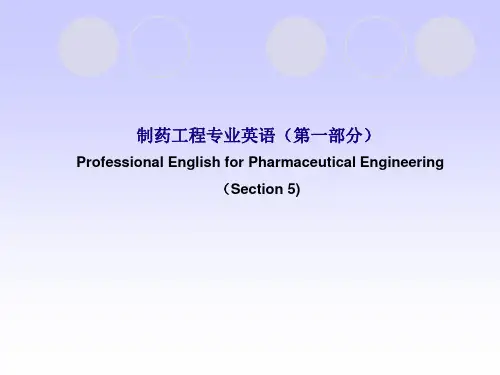
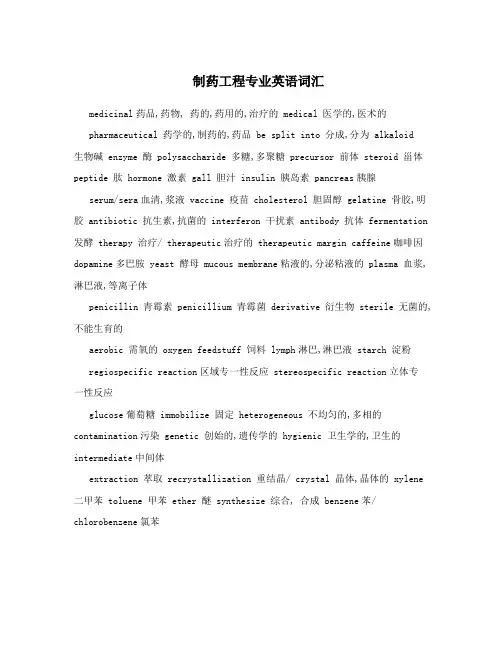
制药工程专业英语词汇medicinal药品,药物, 药的,药用的,治疗的 medical 医学的,医术的pharmaceutical 药学的,制药的,药品 be split into 分成,分为 alkaloid生物碱 enzyme 酶 polysaccharide 多糖,多聚糖 precursor 前体 steroid 甾体peptide 肽 hormone 激素 gall 胆汁 insulin 胰岛素 pancreas胰腺serum/sera血清,浆液 vaccine 疫苗 cholesterol 胆固醇 gelatine 骨胶,明胶 antibiotic 抗生素,抗菌的 interferon 干扰素 antibody 抗体 fermentation 发酵 therapy 治疗/ therapeutic治疗的 therapeutic margin caffeine咖啡因dopamine多巴胺 yeast 酵母 mucous membrane粘液的,分泌粘液的 plasma 血浆,淋巴液,等离子体penicillin 青霉素 penicillium 青霉菌 derivative衍生物 sterile无菌的,不能生育的aerobic 需氧的 oxygen feedstuff 饲料 lymph淋巴,淋巴液 starch 淀粉regiospecific reaction区域专一性反应 stereospecific reaction立体专一性反应glucose葡萄糖 immobilize 固定 heterogeneous 不均匀的,多相的contamination污染 genetic 创始的,遗传学的 hygienic 卫生学的,卫生的intermediate中间体extraction 萃取 recrystallization 重结晶/ crystal 晶体,晶体的 xylene 二甲苯 toluene 甲苯 ether 醚 synthesize 综合, 合成 benzene苯/ chlorobenzene氯苯synthetic, 合成的, 人造的,化学合成品 synthesis [复syntheses] 综合,综合物, 合成(法) semisynthetic, lead structure先导结构 preparation 制备,制剂 isolate使分离,使离析 / isolation heart glycoside tocopherol 生育酚hydrolysis水解/hydrolysate水解产物/hydrolyze水解 hydroxylation 羟基化 dextran 葡聚糖,代血浆 wool 羊毛 ,ーlactamβ-内酰胺amino acid 氨基酸/ amino 氨基的penicilamine 青霉胺 ammonia 氨 ammonium 铵 / ammonium sulfate硫酸铵amine 胺 amide酰胺 microorganism 微生物 microbiological微生物学的mutant 变异的,突变型, 突变体 starting material 起始原料natural source天然来源organ器官/target organ 靶器官 pancreas 胰腺 natural product 天然产物mould 霉,霉菌,发霉high performance 高效bacterial 细菌的 protein 蛋白质degradation 降解 metabolism新陈代谢 / metabolizemetabolite代谢物 molecule /molecular weight food additive organic lactic acid乳酸 citric acid 柠檬酸 tetracycline 四环素 carbon dioxide 二氧化碳 carbohydrate 碳水化合物 saccharide 糖 /多糖 polysaccharide nitrogen 氮 urea 尿素phosphate 磷酸盐 optimal 优化的,最佳的separate vt 分离 absorption 吸收 absorbvt. 吸收 filtration 过滤 filtrate 滤液 filte 过滤,vt, ,过滤器,n, recombinant重组的,重组子 purification 纯化 encode把(电文等)译成电码(或密码), 编码calcium 钙chromatographic procedure 色谱操作步骤 isomerization异构化 /isomeric phenol 酚 fructose 果糖 fumaric acid 富马酸 countless test 非计数的diagnose诊断 diagnostic analysis分析/analyze 分析vt / analyst分析家/ analytical分析的protease 蛋白酶 Ingredient 成分 in combination with 结合 Digestion 消化。

medicinal药品,药物, 药的,药用的 be split intopharmaceutical 药学的,制药的,药品 starting materialsynthetic, synthetics, synthesis, semisynthetic, synthesize,alkaloid 生物硷lead structure intermediateisolation natural sourceenzyme heart glycosidesteroid 甾体 precursor 前体organ/target organ peptidehormone 激素 insulinpancreas vaccinepolysaccharide serumcholesterol 胆固醇 amino acidgelatine hydrolysis水解/hydrolysate水解产物/hydrolyze水解hydroxylation antibiotic 抗生素,抗菌的antibody interferon 干扰素fermentation 发酵 dextran 葡聚糖ーlactam natural producttherapy/therapeutic治疗的/therapeutic margincaffeine咖啡因 yeastmicro b iological mutantmicroorganism geneticmould high performancebacterial proteinmucous membrane degradationmetabolism新陈代谢 metabolite代谢物plasma 血浆molecule /molecular weightfood additive organiclactic acid乳酸 citric acid 柠檬酸penicillin penicilliumtetracycline derivative衍生物contamination污染sterile无菌的aerobic oxygencarbon dioxide carbohydratestarch saccharide/ polysaccharideglucose葡萄糖 nitrogenureaPhosphate optimalammonium sulfate ammoniaseparate filtrateabsorption extractionrecombinant encodepurification chromatographic procedurecalcium regiospecific reaction区域专一性反应stereospecific reaction 立体专一性反应isomerization/isomeric fructosecountless test diagnose diagnosticanalysis/ analyst/ analytical/ analyze protease Ingredient in combination withDigestion enymatic cleavageBy means of fumaric acidBindimmobilize racemate /racemicacetyl heterogeneouscatalysis mediumester synthetic routeregistration compoundOrganometallic pyridinearomatic toluenexylene phenolrecrystallization/crystal methanol/ethanolacetone ethyl acetatebenzene/ chlorobenzene diethyl ethersodium hydroxide hydrochloric acidsulfuric acid nitric acidacetic acid potassium carbonatechlorine/ chloride iodine/iodidefluorine/ fluoride bromine/bromideimpurity quality certificateGMP hygienicin large amount facilityInspection analogousHygienic be subjected toadminister/administration biologic responsebiologic membrane to a large extentpenetration spatial arrangement pharmacologic stereochemistrythree-dimensional structure lipidstructure-activity relationship stericcorrelation parameterpartition coefficient distribution fuction conformation extraction排泄optical isomerism/optical isomer enantiomorphic/ enantiomorph by no means tartaric acidManually magnificationdrug design polarized light dextrorotatory levorotatory Clokwise countclockwiseAntipode nonsuperimposable mirror image Coincide with glyceraldehydeAbsolute literatureconfiguration crystallographyasymmetric center accessisomeric enantiomerdiastereoisomer atomic numberPrioritymagnification solubilityspatial sequencein vivo/in vitro receptorintravenous injection静脉注射 be susceptible to敏感的With respect to contractSubstrate epoxidationcarcinogen oxidation /oxidasepreparation predominantspecies complexdehydrase/dehydrogenase/decarboxylase/hydrolytic enzymes/isomerase/permease Choline one out of every ten 十分之一clinical 临床的 interactionexcrete/excretion inversionCoordination DelayEfficacy in place相称的,合适的entity drug developmentattrition toxicity/toxic/ toxicology/Anti-infectives Healthcarerepro-toxicology/genotoxicity drug candidateindication pharmacokinetics adverse profileformulary/formulation/fornulor onsetdose/once a day dosing dosage/dosage form/overdosage regulatory interdependentsubacute亚急性的/chronic clinical/preclinicalvital optimum/ optimizeimpurity pilot plantcritical path criteriaupdate in paralleladequate stabilitypotency shelf-lifedermal cardiovascular 心血管的respiratory nervousconcurrently labelsynergies 协同作用 antagonizereversible/irreversible permissiblelifespan diseasetumour inhalercapsule rodentfoetal teratologyexposure patchset-up hazardOn a large scale shelf-lifetannin caffeineIn common vacuum fitrationhomogeneous gallic acidhydroxyl group esterifyphenolic precipitatenon-hydrolyzable carboxyl groupacidic calcium carbonatechloroform flavonoiddistillation sublimationsalicylic acid three neck round bottom flask separatory funnel steam bathdistillation flask beakerrinse ozoneice water bath condenserheparin digestionAside from fall intoProvide for as withCation compendialBatch –to batchcoagulation clotdecolorize anticoagulantprecipitation methodologyextraneous intestinalmucosa casingnitrate proteolyticdegrade/ degradation peroxideantithrombin thrombinplatelet aggregationintratracheal parenteraltopical comatoserelegate tabletsyrup suspensionemulsion versusbreakage leakagechip cracktaste masking expirationEven partially portableAdsorbent be free of / be free fromPreference 偏爱 otherwise ad. 另外,别样Burden 负担,负重, on standing 搁置microbiologic preservationdispense bioavailabilitysystemic effects self-administration of medication motion sickness medical emergencysterile ophthalmicirrigate mucouscavity abradeViable 能生长发育的,生存的 Mucous menbraneBody compartment 体室,体腔 Body cavityCircumvent 围绕,包围,智胜,防止…发生,迂回 Exceptionally 特殊地,异常地Wound受伤 Vessel 管,脉管Specialized 专业的,专业性的 By far 非常,更加Monograph专题文章,专题论文 Stringent 严格的,严厉的Inclusive 范围广的 Gravimetric 重量分析法的Electrolytic 电介质的,电解的 Conductivity 电导率Conductance 电导,电导性 Immerse 将…浸入Electrode 电极 Specific 比的Resistance Withstand 经受得住Stress 恶劣的 Redictable 可预报的Reproducible 可重现的 Necessary 必然的Solubilizers 加溶剂 Chelate 螯合Excipient 赋型剂 Ingredient 配料Medicinal agent Dispense 使分散,使疏开,配方(药)Ingenuity 独创性,精明 FormulatorMeager 贫乏的 Continuance 持续pellet vehiclegravimetric instantaneousosmosis dissociatepyrogen antioxidantbuffer tonicityantifungal inhibitorantifoaming colligativeextemporaneous specificationpreparation optimizeaccumulation availabilitydelivery/ deliver peroralrelease sustaingastrointestinal predefinecavity marginionic/ion simulatedistinctly efficacypaddle intestinalinterval a steady-state blood or tissue level elimination blood vesselelectrode/electrolytic conductivity/conductanceresistanceexcipient thermalviable disintegrationresidence time accomplishmaximum/maximize potentiateprescribe uniformitycompliance specificationphysiologic agitationIn the face of 面临 Fluctuation 波动Deliberate 深思熟虑的 Peroral 经口的Depot 仓库 Repository 仓库Sustained release, Sustained action,prolonged action, controlled release,extended action, timed release,repository dosage forms Implicit固有的peak 峰 dumpmaintenance dose maintenance periodmethane, ethane, Propane, butane/tetrane, pentaneethylene, Propylene/propene, butylene, 1-pentenemethanol,ethanol/ethyl alcohol, Propanol/ propyl alcohol, Butanol/Butyl alcohol, 1-pentanolcalibrate asepticstoichiometry replenishmenttubular product yieldscirculate atomizediscrete reactantmaterial transfer regenerationreactant conversion deviate fromviscosityexothermic endothermicshort-circuiting 短路 laminar flowadiabatic radialproduct yields well-stirred batch reactorreactor configuration semibatch reactorcontinous-flow stirred-tank reactorback-mixing返混 cross-sectionpressue drop countercurrentpacked-column rate-limiting stepfluidized or fluid bed tubular reactortubular plug-flow reactor batch operationturbulent trickle bedmultiplicity in series 逐次的,串联的feed Cross-flow 错流,横向流Panel-bed 板式床 reaction driving froces 反应驱动力Chain-terminating Hydraulic 水力学的mechanical seal 机械密封 viscous 粘滞的Be prone to 倾向于, 易于。
1、生产的药品其生产或出身不同药剂可以分为三类:Ⅰ.完全(合成纤维)合成材料,Ⅱ.天然产物,和Ⅲ.产品从(半合成产品)的部分合成。
本书的重点是团体的最重要的化合物Ⅰ和Ⅲ一所以药物合成。
这并不意味着,但是,天然产品或其他代理人并不太重要。
它们可以作为有价值的领导结构,他们常常为原料,或作为重要的合成中间体产品的需要。
表1给出了获取药剂的不同方法的概述。
(表1对药物的可能性准备)方法举例1、全合成,超过75%的药剂(合成纤维)2、分离(天然产物)天然来源:2.1植物-生物碱;酶;心甙,多糖,维生素E;类固醇的前体(薯蓣皂素,sitosterin),柠檬醛(中间产品维生素A,E和K)2.2动物器官一酶;肽激素;胆酸从胆;胰岛素)从胰脏;血清和疫苗2.3从角蛋白和明胶L -氨基酸;三一胆固醇从羊毛油脂的其他来源水解3.一抗生素发酵; L -氨基酸,葡聚糖,对类固醇有针对性的修改,例如11 -羟基化;也胰岛素,干扰素,抗体,肽激素,酶,疫苗4。
部分合成修改(半合成剂)天然产品: 一生物碱化合物;半合成/ 3-内酰胺类抗生素;类固醇;人胰岛素其中几个重要的治疗作用最初是从天然产品天然来源获得更有效的今天,我。
大肠杆菌更经济的准备..由全合成。
这样的例子包括L-氨基酸,氯霉素,咖啡因,多巴胺,肾上腺素,左旋多巴,肽类激素,前列腺素,D -青霉胺,长春胺,以及几乎所有的维生素。
在过去的几年里发酵-岛大肠杆菌微生物过程变得极其重要。
通过现代技术和基因选择的结果导致了突变体的微生物创造高性能,发酵,已成为首选方法各种各样的物质。
这两个Eukaryonts(酵母菌和霉菌)和Prokaryonts(单细胞细菌,放线菌和)用于微生物。
下列产品类型可以得到:1.细胞的物质(单细胞蛋白),2.酶,3.主要降解产物(主要代谢物),4.二级降解产物(次生代谢物)。
不顾来自某些微生物,大肠杆菌粘膜生产的葡聚糖克明串珠mesenteroides,2和3级是毒品有关的准备工作。
Unit 11.Depending on their production or origin pharmaceutical agents can be splitinto three groups: Totally synthetic material (synthetics) Naturalproducts ,and Product from partial syntheses (semi-synthetic products)依据其生产或来源,药物制剂可以分为三类:I.完全的合成材料(人工合成材料),II.天然产物,和III.源自部分合成的产品(半合成产品)。
2.The emphasis of the present book is on the most important compounds ofgroups I and III-thus Drug synthesis.翻译:所以本书的重点是I和III部分的药物合成。
本书的重点是在于Ⅰ和Ⅲ类中最重要的化合物——药物合成。
3.This does not mean, however , that natural products or other agents are lessimportant.然而这并不意味着,天然产物和其他试剂不重要。
4.they can serve as valuable lead structures, and they are frequently needed as starting materials or as intermediates for important synthetic products.它们可以作为有价值的先导结构,他们常常作为重要的合成产品的起始原料或中间体产品。
5:Table1gives an overview of the different methods for obtaining pharmaceutical agents.表1列出了获取药物制剂的不同方法的概述。